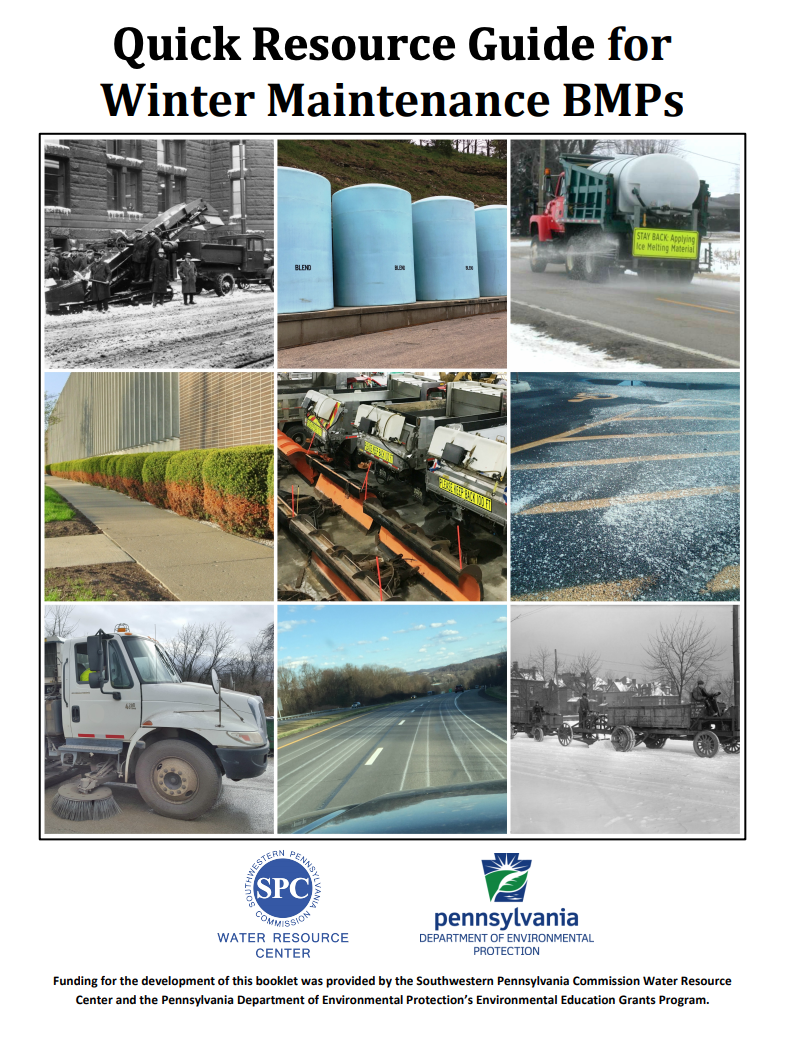Transportation Planning
Pennsylvania has over 119,000 miles of roads, 412 airports, 22,691 bridges, and 5,127 miles of railroads (US Transportation Construction Industry Profile, 2015). Transportation systems are a main driver of economic activity but they can adversely affect water resources. Impervious surfaces such as roads, bridges, highways, and airport runways can lead to increased stormwater runoff and decreased water quality. Stormwater runoff from impervious surfaces can contribute to flooding and also carry pollutants such as sediment, bacteria, trash, excess nutrients, chemicals, and oils into local waterways. Runoff pollutants can be managed in many different ways to protect water resources while maintaining transportation infrastructure at the design phase, through permitting and construction, and by maintaining infrastructure properly.
Design
Environmental land use planning and transportation come together at the design phase. There are considerations on both sides to create safe transportation infrastructure while protecting the natural environment. One way to design transportation infrastructure with water resources in mind is by utilizing green infrastructure (GI). Green infrastructure can be incorporated into transportation infrastructure or sited alongside it. Tree trenches and permeable pavement can be built into transportation systems while grass swales, wetlands, or living retaining walls can be used alongside transportation corridors such as highways or railroads. See the Water Resource Center’s factsheets on stormwater best management practices (BMPs) or the PA Stormwater Best Management Practices (BMP) Manual for a full list of green infrastructure types and siting. The National Association of City Transportation Officials created an Urban Street Stormwater Guide to assist in planning safe transportation infrastructure while protecting the natural environment. The US Federal Highway Administration (FHWA) highlights success stories of combining stormwater infrastructure and multimodal road design. Siting is important when implementing green infrastructure to maintain safety. For example, constructing a wetland near an airport runway could attract wildlife that might interfere with flight patterns.
Stormwater infrastructure can also provide benefits to transportation systems such as traffic calming and reducing roadway flooding. See the presentation by EOA, Inc. on “Integrating Transportation and Green Infrastructure” for more information.
Permitting and Construction
Construction sites have a high possibility of sediment runoff from the site into local streams during precipitation events. Being that sediment is the primary water pollutant in the United States, it is important to manage stormwater runoff during the construction phase of land disturbance projects such as roads, bridges, and railroad construction. Permits must be obtained to manage soil disturbance and its impact on water resources. These permits can include PA Chapter 103, Chapter 105, and/or a joint PA DEP/USACE permit. An environmental impact statement may also be required. Consult your county conservation district or PA Department of Environmental Protection for more information.
Maintenance
Maintenance of transportation infrastructure and stormwater BMPs is critical to its success in protecting public safety and water resources. For specific information on stormwater BMP maintenance, see our BMP Maintenance page.
Winter Maintenance
Maintenance of roads, bridges, runways, parking lots, and sidewalks is especially important during winter season in Southwestern Pennsylvania. To protect public safety and allow travel during winter weather conditions, snow and ice are cleared using plows and road salt, which can negatively impact water resources if overused. The Water Resource Center has developed a Quick Resource Guide for Winter Maintenance BMPs to help municipalities understand positive ways to protect public safety while saving money and protecting natural resources.
Pennsylvania Dirt, Gravel, and Low Volume Roads (DGLVR) Maintenance Program
The Pennsylvania Dirt, Gravel, and Low Volume Roads (DGLVR) Maintenance Program, also referred to as the Dirt and Gravel roads program, is a funding source for implementing projects that protect water quality while maintaining road infrastructure. This program aims to directly reduce the amount of sediment (the largest water pollutant in the commonwealth by volume) entering local waterways. Funding is allocated from the PA State Conservation Commission to county conservation districts who administer the DGLVR program. State and local public entities then apply to the conservation district for funding to maintain their locally-owned roads. Find more information on the DGLVR Maintenance Program from the PennState Center for Dirt and Gravel Road Studies or find your local county conservation district here.
Risks and Threats
Sinkholes
An emerging concern for western Pennsylvania is sinkholes, which are defined by the PA Department of Conservation and Natural Resources as “a subsidence feature resulting from the downward movement of superficial material into a pre-existing subsurface void.” Sinkholes can be natural but may be exacerbated by human activities. Sinkholes are a typically caused by movement of subsurface water through geology, leading to shifting of the surface. Sinkholes can cause safety concerns if they occur under roads, leading to millions of dollars in repairs. Find more information about sinkholes on DEP’s website, DCNR’s website, or Sinkholes in Pennsylvania publication (Kochanov, 2015).
Landslides
Landslides are another phenomenon that impact western Pennsylvania and its infrastructure. Defined by PA DCNR as “a general term for the downslope mass movement of soil, rock, or a combination of materials on an unstable slope,” landslides can be a natural occurrence but can be exacerbated by human activity such as land development. The SPC region has the highest susceptibility to landslides in the commonwealth, due to the topography and geology. Find more information about landslides on DCNR’s website, Landslides in Pennsylvania publication (Delano and Wilshusen, 2001), Landslides in the Greater Pittsburgh Region publication (Pomeroy, 1982), and the Allegheny County Landslide Portal.
For more information on transportation planning, visit Southwestern Pennsylvania Commission’s Transportation Planning site.
Explore Planning and Resiliency Tools and Resources

